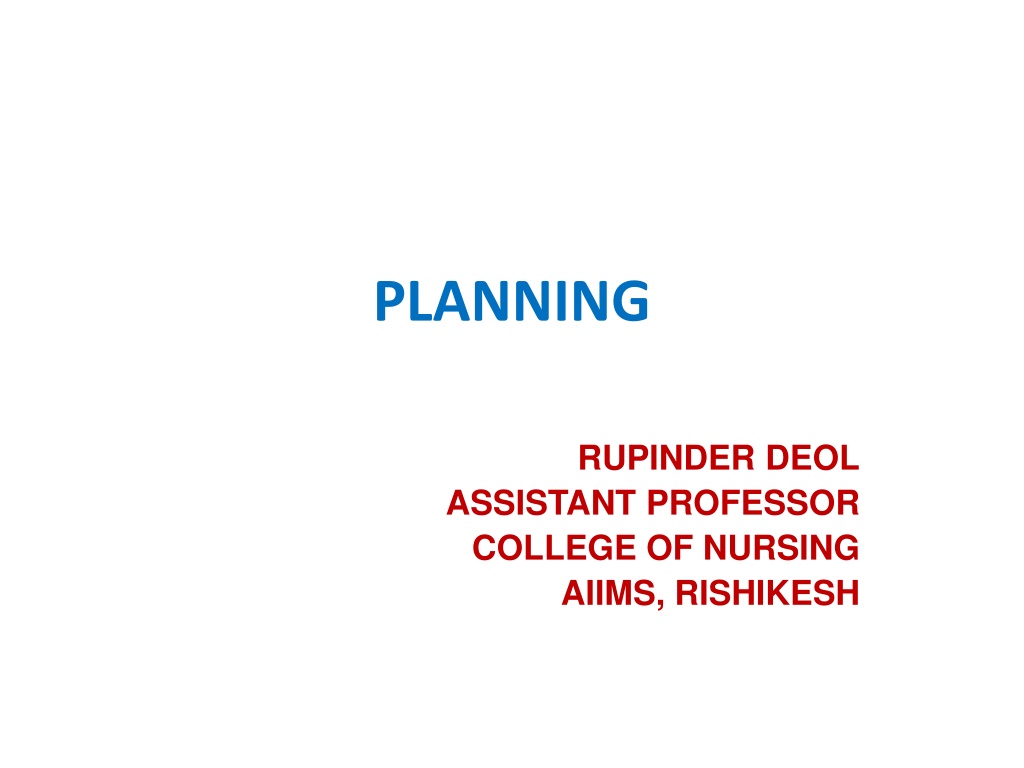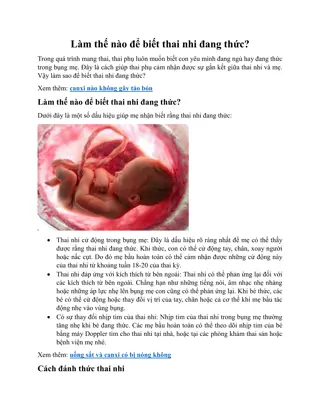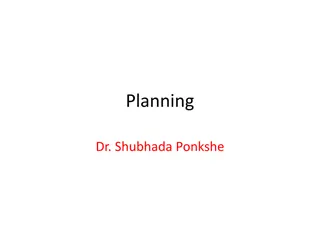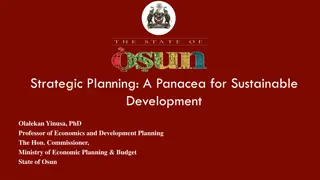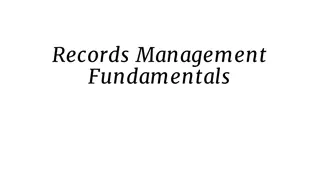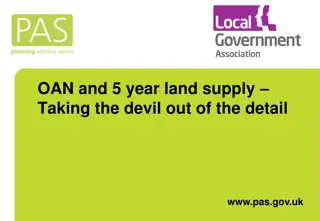The Fundamentals of Planning in Management
Planning is a crucial managerial function that involves defining objectives, establishing strategies, and developing plans to coordinate activities. It is the first step in the management process, providing direction to organizations and guiding decision-making. Through a rational and systematic approach, planning enables organizations to anticipate the future, analyze opportunities, and make informed decisions to achieve set goals effectively.
Download Presentation

Please find below an Image/Link to download the presentation.
The content on the website is provided AS IS for your information and personal use only. It may not be sold, licensed, or shared on other websites without obtaining consent from the author.If you encounter any issues during the download, it is possible that the publisher has removed the file from their server.
You are allowed to download the files provided on this website for personal or commercial use, subject to the condition that they are used lawfully. All files are the property of their respective owners.
The content on the website is provided AS IS for your information and personal use only. It may not be sold, licensed, or shared on other websites without obtaining consent from the author.
E N D
Presentation Transcript
PLANNING RUPINDER DEOL ASSISTANT PROFESSOR COLLEGE OF NURSING AIIMS, RISHIKESH
PLANNING DEFINED Defining the organization s objectives or goals Establishing an overall strategy for achieving those goals Developing a comprehensive hierarchy of plans to integrate and coordinate activities Planning is concerned with ends (what is to be done) as well as with means (how it is to be done).
Planning is the first managerial function to be performed. It is concerned with deciding in advance what is to be done in future, when, where and by whom it is to be done. It is a process of thinking before doing. Without the activities determined by planning, there would be nothing to organize, no one to activate and no need to control . George R. Terry
Planning is a technical managerial function that enables organizations to deal with the present and anticipate the future. It is the first and fundamental function of management because all other management functions are dependent on it. Planning is deciding what is to be done, when it is to be done, how it is to be done and who is to do it. It is an orderly process that gives organizational direction. Planning is the process of determining how the organization can get where it wants to go.
Planning is the process of determining exactly what the organization will do to accomplish its objectives. In more formal terms, planning has been defined as the systematic development of action programmes aimed at reaching agreed objectives by the process of analyzing, evaluating and selecting among the opportunities which are foreseen.
NATURE OF PLANNING Planning is a comprehensive term & involves choosing a course of action from all available alternatives for accomplishing the desired results which are economical & certain. Planning sketches a complete mental picture of things yet to happen in the enterprise through the process of looking ahead. Planning is a rational, dynamic and integration process. Planning cannot be haphazard or improvised. It is never the result of chance or unconscious effort. Planning is a process involving conceptual & analytic skills, critical thinking, decision making & problem solving.
Planning is selecting & relating facts & the making & using of assumptions regarding the future in the visualization & formulation or the proposed activities believed necessary to achieve the desired results. Planning is a rational, conscious & deliberate effort. Planning is not a static process, it is dynamic & needs continuous adaptation in the light of experience, constant evaluation, review & follow up. Planning is a comprehensive & integrative process, not confined to any one branch of knowledge. Planning is the conscious determination of a future course of action to accomplish a defined objective. Planning is inevitable at all levels of administration.
PURPOSE OF PLANNING It gives direction to the organization. It improves efficiency It eliminates duplication of efforts. It concentrates resources on important services. It reduces guess work. It improves communication and coordination of activities
IMPORTANCE OF PLANNING 1. It attempts to offset uncertainty by foreseeing the future & bringing about preparedness for the happening in future. 2. It focuses attention on the objectives or goals of the organisation & their achievement. 3. It leads to economy in operation through the selection of the best possible course of action. 4. It helps in controlling the activities by providing measures against which performance can be evaluated. 5. It helps in coordinating the operations of an organization since a well-considered plan embrace & unifies all divisions in an organisation.
FEATURES OF PLANNING 1. Focus on realizing the objectives set 2. Intellectual process involving mental exercise 3. Selective as it selects the best course of action 4. Pervasive as all the levels of management plan 5. Lays foundation of the successful actions of management 6. It is flexible 7. It is Continuous 8. Efficiency is measured by what it contributes to the objectives.
OBJECTIVES OF PLANNING 1. Helps in effective forecasting 2. Provides certainty in the activities 3. Establish coordination in the enterprise 4. Provides economy in the management 5. Helpful in the accomplishment of budgets 6. Gives direction to all the activities of an organization
PRINCIPLES OF PLANNING 1. Planning must focus on purposes. It should always be based upon clearly defined objective. 2. Planning is a continuous & iterative process which includes series of steps, so continuity & flexibility should be maintained in planning cycle. 3. Planning should be simple & there should be provision for proper analysis & classification of actions. 4. In planning, there should be a good harmony with organization & environment. 5. Planning is hierarchical organizational identification. in nature & must have
6. Planning should be persuasive activity covering the entire organization with all its departments, sectors & different levels of administration, and it should be balanced. 7. Planning must be precise in its objective, scope and nature. It should be realistic in its scope & pinpoint the expected results. 8. In planning the provision should be made to use all available resources. 9. Planning should always be documented so that all the concerned are fully committed to the implementation of the programme.
6 Ps in Planning Purpose Philosophy Premise Policies Plans Priorities
CHARACTERISTICS OF PLANNING 1. Primacy: Precedes other elements or functions of administration. 2. Continuity: never ending activity. One plan begets another plan. 3. Flexibility 4. Unity 5. Precision 6. Pervasiveness: responsibility of all members at different levels of management.
MERITS AND DEMERITS OF PLANNING Advantages: 1.Reduces uncertainty 2.Ensures economical operations 3.Facilitates control 4.Improves motivation 5.Gives competitive edge 6.Avoids duplication of efforts Disadvantages : 1.Limitations of forecasts 2.Rigidity in administration 3.Time consuming process 4.Costly affair 5.Influence of external factors 6.Psychological factors
Criticisms Of Formal Planning Planning may create rigidity. Plans can t be developed for a dynamic environment. Formal plans can t replace intuition and creativity. Planning focuses managers attention on today s competition, not on tomorrow s survival. Formal planning reinforces success, which may lead to failure.
Planning and Performance Formal planning generally means higher profits, higher return on assets, and other positive financial results. Planning process quality and implementation probably contribute more to high performance than does the extent of planning. When external environment restrictions allowed managers few viable alternatives, planning did not lead to higher performance.
Types of Plans BREADTH OF USE TIME FRAME SPECIFICITY FREQUENCY OF USE Strategic Long term Directional Single use Tactical Short term Specific Standing
PLANNING: FOCUS AND TIME Strategic plans Plans that are organization-wide, establish overall objectives, and position an organization in terms of its environment Tactical plans Plans that specify organization s overall achieved Short-term plans Plans that cover less than one year Long-term plans Plans that extend beyond five years the details objectives of are how an be to
STRATEGIC PLANNING Strategic plans Apply broadly to the entire organization Establish the organization s overall objectives Seek to position the organization in terms of its environment Provide direction to drive an organization s efforts to achieve its goals. Serve as the basis for the tactical plans. Cover extended periods of time Are less specific in their details
TACTICAL PLANNING Tactical plans (operational plans) Apply to specific parts of the organization. Are derived from strategic objectives Specify the details of how the overall objectives are to be achieved. Cover shorter periods of time Must be updated continuously to meet current challenges
STRATEGIC AND OPERATIONAL PLANNING Strategic Planning The process of developing a mission and long- range objectives and determining in advance how they will be accomplished. Operational Planning The process of setting short-range objectives and determining in advance how they will be accomplished. Strategy A plan for pursuing the mission and achieving objectives.
SPECIFIC AND DIRECTIONAL PLANS Specific plans Plans that have clearly defined objectives and leave no room for misinterpretation What, when, where, how much, and by whom (process-focus) Directional plans Flexible plans that set out general guidelines Go from here to there (outcome-focus)
SINGLE-USE AND STANDING PLANS SINGLE-USE PLANS A plan that is used to meet the needs of a particular or unique situation Single-day sales advertisement STANDING PLAN A plan that is ongoing and provides guidance for repeatedly performed actions in an organization Customer satisfaction policy
THE PLANNING HIERARCHY Planning responsibilities are different for managers at each organizational level. Strategic planning Top-level managers, formulate planning to reinforce the firm s mission (the mission clarifies organizational purpose) Strategic plans are specified for five years period or more; but circumstances dictate the planning horizon. Tactical planning Middle management is strategies into shorter-term tactics. Tactical plans are often specified in one-year increments. Eg. annual budget. long-term strategic responsible for translating
Translating strategic plans into measurable tactical objectives is important because most strategic objective is rather vague. Operational planning Operational planning is managers. Operational planning is most concerned with budgets, quotas and schedules. These are refinements of tactical objectives in which work is defined and results are measured in small increments. Time horizon for operational planning is very short. Most plans at this level reflect operational cycles. accomplished by fist-line
Operational objectives are: - Narrow in scope - Short-lived - Subject to sudden change. In order to fulfil her/his own job responsibilities and to guide subordinates towards agency goals, the nurse manager must spend scarce materials and human resources wisely. Since the nursing service operation in even a small agency is immensely complicated, careful planning is needed to avoid waste, confusion and error.
THE FORMAL PLANNING PROCESS Formal planning is a systematic process. It consists of five guidelines. These guidelines provide a general pattern of rational planning. 1. Situation audit or environmental assessment It analyzes the Past, current and future forces that affect the organization. Expectation of outside interests such as government officials, insurance companies sought. Expectations of inside interests such as nurses, doctors, administrators and other staffs are collected. Environment, demographic, technological factors should also be considered. and consumers are resources, legal,
2. Establish Objectives Every plan has the primary purpose of helping the organization succeed through effective management. Success is defined as objectives. These are performance targets, the end results that managers seek to achieve. 3. Involve management and staff Involving a greater number of managers will result in better plans and more wide spread acceptance of objectives. achieving organizational
4. Develop alternatives A successful planning process will generate several options for manages to consider. These options are alternative courses of action that can achieve the same result. The task of management is to decide among them. Managers usually consider many alternatives for a given situation, but a viable alternative suggests a proposed course of action that is: Feasible Realistic Sufficient
5. Communicate plans Planning requires clear and effective communication at all levels before performance expectations. Objectives are written and plans are documented to give employees direction. Managers communicate plans into two categories: begins to mirror
A. Standing use plans- are those that are used on a continuous basis to achieve consistently repeated objectives. Standing plans take the form of: - Policies - Procedures - Rules B. Single use plans-are those that are used once to achieve unique objectives or objectives that are seldom repeated. They are communicated through: - Programs - Budget - Schedule
STEPS IN PLANNING 1. Awareness of opportunities and problems a) What business opportunities will arise in future b) What benefits will the organization get c) How to exploit these opportunities 2. Collecting and analyzing information 3. Determination of objectives 4. Assessment of environment 5. Premising and forecasting 6. Review of key factors 7. Development of alternative plans 8. Evaluation of alternative plans 9. Selection of a suitable plan
STEPS OF PLANNING 1. Analysis & understanding of system 2. Formulation of operational goals & objectives 3. Establishment of planning premises 4. Selection & formulation of operative plan for alternatives 5. Securing participation 6. Implementation 7. Follow up to the proposed course of action 8. Evaluation 9. Reanalysis and new understanding of system.
KINDS OF PLANNING KINDS OF PLANNING Organizational level Focus Time period Corporate Strategic Divisional Operational Functional Tactic Long range Medium range Short range
ORGANIZATIONAL PLANNING Corporate planning or top level planning: It lays down the objectives, policies and strategies of an organization. Usually made for a longer time period. Divisional planning or middle level planning: It is related to a particular department or division. It lays down the objectives, policies and strategies of a department. Sectional planning or lower level planning: focused on laying down detail plans for the day to day guidance.
FOCUSED PLANNING 1. Strategic planning: deciding the objectives and to decide the resource marshalling in order to realize the objectives. Done by the top management. 2. Operational planning: ensuring efficient use of resources and to develop a control mechanism so as maximum efficiency is ensured. 3. Tactical planning: made for short term moves. Required to meet the sudden changes in the environment forces.
TIME PERIOD PLANNING 1. Long range planning: for a period of five years at least. Involves capital budgeting, product planning, project planning etc. deals with a great uncertainty. 2. Medium range: for one to five years. Relate to development of new products and markets, product publicity etc. supportive to long range plans. 3. Short range: upto one year. Made to achieve short term goals. Focused on the internal environment of the business.
COMPONENTS OF PLANNING Objectives Policies Procedures Programme Budget
BASIC TERMS 1. Objectives: these are the end towards which the activities of an organization are directed. 2. Policies: Policies provide the framework within which the decision makers are expected to operate while making decisions related to an organization 3. Procedures: These are the administrative specifications prescribing the time sequence for work to be done. They tell us how a particular activity is to be done.
BASIC TERMS 4. Methods: It is a means by which each operation is performed. It also specifies how a particular step in the procedure is to be performed. 5. Rules: it specifies what is to be done and what is not be done. More rigid than a policy. 6. Strategy: It refers to the firm s overall plan for dealing with and existing in the environment.
POLICIES Policies provide the framework within which the decision makers are expected to operate while making decisions related to an organization. They are guide to the thinking and action of subordinates for the purpose of achieving the objectives of the business successfully.
NATURE OF POLICY 1. Policy is an expression of intentions of top management. 2. It serves as a guide to decision making in an organization. 3. It should be planned after taking into consideration the long range plans and needs of an organization. 4. As policies live longer than the people therefore the policies should be framed after serious thinking and participation of the top executives. 5. Policies take a concrete step when they are put in writing.
TYPES OF POLICIES Basic or top management policy: laid by the top 1. management like product selection, size of business, budgeting etc. Middle management policies: general policies affecting a 2. large part of organization. E.g. purchase policy Departmental Policies: applies to routine activities e.g. 3. workers related matters 4. Written and verbal policies
TYPES OF POLICIES 5. Implied policies: which actually exist in a company. Such policies can be known only by watching the actual working of an organization. 6. Functional policies: e.g. marketing policies, finance policies, research policies, and recruitment policies. 7. Policy manual: where all policies are compiled in the form of a book is called a policy manual.
